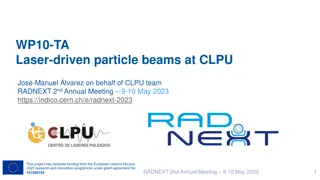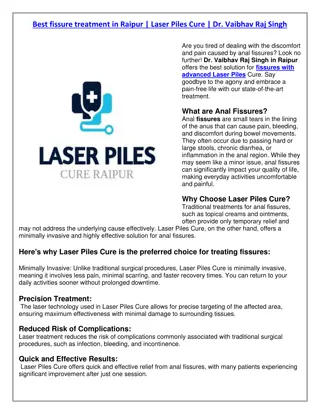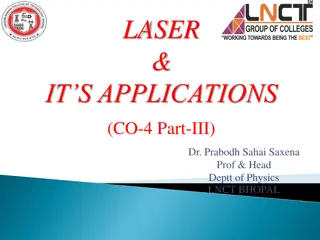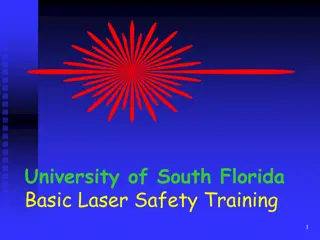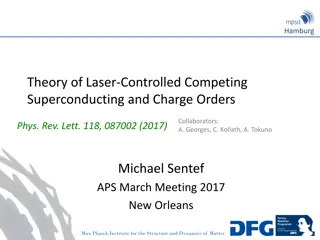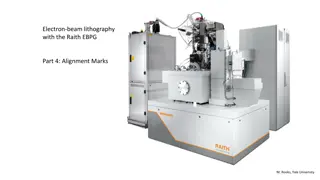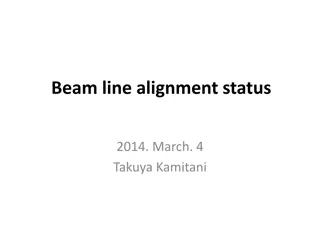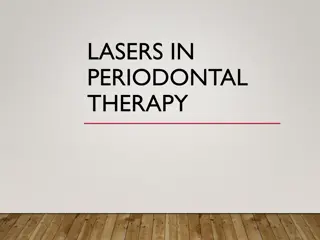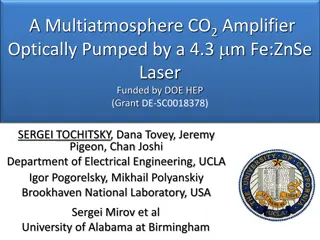Laser Alignment Training for Safety
This laser alignment training program focuses on exercises like wedge window alignment and beam splitter cube alignment to prevent laser eye injuries and control reflections. It covers techniques for safely setting up optics and aligning laser beams in a controlled environment.
Download Presentation

Please find below an Image/Link to download the presentation.
The content on the website is provided AS IS for your information and personal use only. It may not be sold, licensed, or shared on other websites without obtaining consent from the author. Download presentation by click this link. If you encounter any issues during the download, it is possible that the publisher has removed the file from their server.
E N D
Presentation Transcript
EHS 304 Laser Alignment Training EHS 304 Laser Alignment Training Laser Safety Program 2018
Exercise # 1. Wedge Window Alignment Exercise # 1. Wedge Window Alignment Maximum time for completing the exercise: 30 minutes Overview The alignment and setup of wedge window assembly presents high potential for laser eye injury and uncontrolled secondary back reflection as a wedge consist of two reflective surfaces and can potentially be oriented in such a way to expose directly the back reflection upward or towards an undesired path. The users will learn how to safely mount and setup a wedge window. The wedge window used in this exercise is: LW3-1037C, Fused Silica, Uncoated, 3o wedge Tools Laser protective eyewear for 638 nm Beam blocks Fluorescent cards 3
Wedge Window Alignment Wedge Window Alignment OPTICAL LAYOUT MIRROR 1 DIODE LASER TARGET BEAM BLOCK 1.4 mW, 638 nm BEAM BLOCK WEDGE WINDOW MIRROR 2 BEAM BLOCK IRISES TASKS: 1. Start with the laser beam blocked or disabled. Put on the appropriate laser protection goggles. 2. Position a beam block between the mirrors. Enable the red laser and open the beam. 3. Align so the beam is on the first mirror. Block the beam at the laser aperture. 4. Place a beam block between the second mirror and the first iris. Open the beam. Align so the beam is on the second mirror. 5. Block the beam. Close both irises and place beam block behind the first one. Open the beam. 6. Align such as the beam is centered on the closed first iris. Block the beam. Move the beam block behind the second iris. 7. Unblock the laser and open the first iris to allow the beam to reach the second iris. Align so the beam is centered on the second iris. 8. Iterate these steps until both irises are correct. Verify for stray reflections with a card. 9. Block the laser. Move the beam blocks around the wedge window. Open the second iris. 10. Holding a card at front of the window, adjust the window mount so the beam enters the window aperture. 11. Check for front and back surface reflections. Be careful, if positioned incorrectly, the reflected beam may be upward. 12. Rotate the window inside the mount or the mount itself so that reflected beam would be on the target or horizontal. Find the back reflection beam and either align it on target or block it. Use gloves if touching the optics. 13. Perform two point unique alignment, to verify that the beam is in horizontal plane. Iterate these steps until both targets are correct. 14. Verify that all beams, including reflected or stray beams, are contained. 4 15. Block the laser or turn it off.
Exercise # 2. Beam Splitter Cube Alignment Exercise # 2. Beam Splitter Cube Alignment Maximum time for completing the exercise: 15 minutes Overview The alignment and setup of polarizing beam splitter cube presents high potential for laser eye injury and/or uncontrolled reflections as a polarizing cube consist of two polarized orthogonal reflections coming from two orthogonal surfaces. Typical mounting of such optic allows for 360o rotation, therefore presenting high risks for upward and unsafe beam path. The students will learn how to safely mount a non-polarizing beam splitter cube: Broadband Dielectric Non-Polarizing Beamsplitter Cube 12.7 mm, 400-700 nm 50/50 splitting for un-polarized light Multilayer broadband dielectric coating CW and low-energy pulsed laser applications Tools Laser protective eyewear for 638 nm Beam blocks Fluorescent cards 5
Beam Splitter Cube Alignment Beam Splitter Cube Alignment OPTICAL LAYOUT MIRROR 1 DIODE LASER REFLECTED BEAM TARGET 1.4 mW, 638 nm BEAM BLOCK MIRROR 2 IRISES BEAM SPLITTER CUBE BEAM BLOCK TASKS: 1. 2. 3. 4. 5. Start with the laser beam blocked or disabled. Remove (or leave in) the wedge window mount. Repeat tasks 2 thru 8 from Exercise # 1 if not completed already. Block the laser. Place a beam block at front of the cube. Open the second iris. Unblock the beam. Adjust the mount so the beam enters the cube aperture. Rotate/adjust the beamsplitter mount so that reflected beam would be in horizontal plane and on the target. Check for stray beam at all sides. Verify all beams, including reflected or stray beams, are contained. Block the laser or turn it off. 6. 7. 8. 6
Exercise # 3. IR Beams and Flipper Mirror Setup Exercise # 3. IR Beams and Flipper Mirror Setup The following experimental setups are designed to teach one specific skill related to laser hazard commonly encountered in laser laboratories and setups. Maximum time for completing the exercise: 15 minutes Overview The alignment and setup of a flipper mirror assembly presents high potential for laser eye injury as it can be set improperly and provide a risk to redirect a laser beam at a multitude of upward angles during the flipping motion. Always mount the flip mirror to flip downwards! Tools Laser protective eyewear for 852 nm Beam blocks Fluorescent cards 7
IR Beams and Flipper Mirror Setup IR Beams and Flipper Mirror Setup OPTICAL LAYOUT BEAM BLOCK IRIS IRIS MIRROR 2 FLIPPER MIRROR ASSEMBLY MIRROR 1 IR DIODE LASER BEAM BLOCK MIRROR 3 3.8 mW, 850 nm TASKS: 1. Start with the laser beam blocked or disabled. Remove the flipper mirror and the lenses mounts if in place. 2. Position a beam block at front of the first lens. Close the irises. 3. Put on the appropriate laser protection goggles. 4. Enable the IR laser. Holding a card on top of the mirror, adjust the laser such as the beam is on the Mirror 1. Remove the card. Block the beam at the laser, place beam blocks behind the first and second irises. 5. Open the beam, align it to be centered on the closed first iris. 6. Block the beam. Open the first iris, open the beam and center the beam on the second iris. 7. Proceed aligning the beam to Mirror 2 and Mirror 3 to final target on beam block using the safety skills learned in previously such as walking the beam from optic to optic with a card. Now you have the beam aligned. 8. Block the beam. Insert the flipper mirror in its mount. Place a beam block behind it. 9. Open the beam and align the beam so the beam reflection is redirected toward the beam block by the perimeter guard.. 10. Always flip the mirror when the beam is blocked! 11. With the goggles on, use the IR viewer and verify all beams, including reflected or stray beams, are contained. 12. Block the laser or turn it off. 8
Exercise # 4. IR Beams and Telescope Alignment Exercise # 4. IR Beams and Telescope Alignment Maximum time for completing the exercise: 15 minutes Overview The alignment and manipulation of IR beams pose a practical and safety problem due to the fact that the beam is invisible to the human eye. Therefore, any unexpected beams or scattered light cannot be detected visually. It requires additional laser tools that students will get familiar with. Additionally, introduction of lenses into the beam path may pose safety concerns as it generates diverging and converging beams that need to be considered and controlled. The lenses used in this exercise are: LC1582-B, -75 mm, 1 , N-BK7, Plano Concave LA1986-B, +125 mm, 1 , N-BK7, Plano Convex Tools Laser protective eyewear for 850 nm Beam blocks IR and Fluorescent cards IR viewer 9
IR Beams and Telescope Alignment IR Beams and Telescope Alignment OPTICAL LAYOUT BEAM BLOCK IRIS IRIS MIRROR 2 MIRROR 1 +125 mm LENS -75 mm LENS IR DIODE LASER BEAM BLOCK MIRROR 3 3.8 mW, 850 nm TASKS: 1. Start with the laser beam blocked or disabled. Remove (or flip down) the flipper mirror and the lenses mounts if in place if not done already. Repeat steps 2 thru 7 from Exercise # 3. Position the lenses in their mounts. Using the safety skills learned in previously (such as walking the beam from optic to optic with a card), align the beam thru the lenses. Check beam collimation. Observe motion of beam on beam block behind the +125 mm lens. Optional task: you can change the distance between the lenses, place them at some angle, or rotate them to observe different optical effects such as telescope adjustment for beam collimation, telescope adjustment to focus at desired plane, telescope adjustment for astigmatism, filter strength and reflections. With the goggles on, use the IR viewer and verify all beams, including reflected or stray beams, are contained. Block the laser or turn it off. 2. 3. 4. 5. 6. 7. 10
Exercise # 5. Periscope Alignment Exercise # 5. Periscope Alignment Mandatory exercise, Maximum time for completing: 30 minutes Overview The alignment of a periscope of any type (up (down)-and-over or plane-vertical) present high potential for laser eye injury as it re-directs the beam in both the horizontal and vertical plane. A careful alignment process is required to ensure that all reflections are considered and controlled at all time. Additional safety measures are also suggested in this exercise as good practice to avoid scattered or direct exposures. Tools needed Laser protective eyewear for 532 nm Beam blocks Fluorescent cards 11
Periscope Alignment Periscope Alignment BEAM BLOCK IRISES PERISCOPE ASSEMBLY OPTICAL LAYOUT DIODE LASER 5mW, 532 nm TARGET TASKS: 1. Start with the laser beam blocked or disabled. Remove the polarizing beam ND filter if present. 2. Close both irises and place beam blocks behind the first and second isis. 3. Put on the appropriate laser protection goggles. 4. Enable the green laser and remove the beam block if present. 5. Adjust the laser such as the beam is centered on the closed first iris. Block the beam. 6. Unblock the beam and open the first iris to allow the beam to reach the second iris. 7. Align so the beam is centered on the second iris. Verify for stray reflections with a card. 8. Block the laser. Open the second iris. 9. Covering the upper mirror with a card, unblock the laser. Adjust the upper mirror so that the beam enters the mirror aperture. Align the mirror until the beam is pointing vertically down. 10. Move the card to cover the lower mirror, when beam is correct on the mirror, align the beam toward the target. 11. Perform two point unique alignment, to verify that the beam is in horizontal plane (optional). 12. Verify that there are no stray beams and all beams are contained. 13. Block the laser or turn it off. 12
Exercise # 6. Attenuation Filters Exercise # 6. Attenuation Filters Maximum time for completing the exercise: 15 minutes Overview The introduction of attenuator or other filters (such as band pass filters) into the beam path may pose safety concerns as it generates back reflections that need to be controlled at all time. The neutral density filter used in this exercise is: NE203B, 50.8mm Square Absorptive ND Filter, ND=0.3 Tools Laser protective eyewear for 532 nm Beam blocks Fluorescent cards 13
Attenuation Filters Attenuation Filters BEAM BLOCK PERISCOPE ASSEMBLY OPTICAL LAYOUT DIODE LASER 5mW, 532 nm ND FILTER IRISES TARGET BEAM BLOCK TASKS: 1. 2. 3. Start with the laser beam blocked or disabled. Use the already aligned beam in Exercise #5. Place a beam block at front of the periscope. Insert the ND filter intentionally offset. Hold the detector card close to the filter in the way you know the reflection will go before unblocking. Open the beam. If practiced correctly, the beam is always on the card. Rotate the filter to the right position while holding the card. This way the reflected beam is never uncontrolled. Once the filter is in the final position, block the reflected beam. If desired, remove the beam block behind the ND filter and continue aligning the beam as in previous exercise. Verify that there are no stray beams and all beams are contained. Block the laser or turn it off. 4. 5. 6. 7. 8. 14





